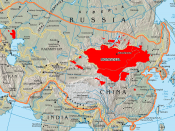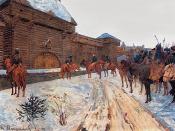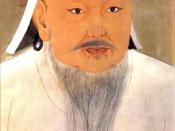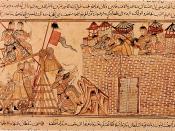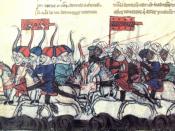Psychological OperationsThere is no doubt that all warfare contains some psychological impact on the protagonists. This mental element is an integral part of warfare, sometimes intentional on the part of the antagonists, sometimes merely a byproduct. Many think that psy-ops are a recent invention; in fact they are almost as old as warfare itself. Morale is just as important to a military effort as food and weapons. Smart commanders recognize this and realize that hurting the morale of an enemy is another stepping stone to victory. On the other side of the battlefield commanders use every means possible to keep up the morale of the troops because high morale is an advantage just like superior weaponry or battlefield position. The Mongols took the battlefield ups and downs of morale to the next level. Often during the Mongols' conquests this battle of morale was the only battle that was fought. The Mongols' use of psychological battle was divided into three parts that was based on time; during the battle, after a battle, before a battle was concluded.
The time during a battle and after a battle need to be explained first because they often affected the outcome of the next battle.
The Mongol armies had a tremendous ability to shock and awe an opponent with their speed, tactics, and the outlandishness of their military style. This was especially true farther west. China had become accustomed to their nomadic neighbors to the north and their warlike ways over centuries of playing them off each other. Farther west the Arabs and Europeans had never heard of the Mongols and had small warning before they starting seeing dust on the horizon. This shock and awe was a key part in capturing cities that had strong walls and fortifications. The Mongols would often approach a city at full speed and create a tremendous dust cloud then stop and wheel around to approach from a different position.1 They might do this several times to disorient the enemy and show them that they could attack from any side at any time. This kept the defenders on their toes the whole time they were under siege because they had to man the whole wall all the time instead of just manning the side the Mongols were facing. The defenders would start wearing down from the strain and not being able to rest. The Mongols on the other had could send a few parties out every once in a while to kept the defenders at a fever pitch while the main army slept.
Another favorite tactic of the Mongols was the use of their extra horses to falsely inflate the size of their army.2 Each member of their cavalry had a string of 5 or 6 horses so they would put stuffed dummies up on the spare horses so from a distance it would look like the force was many times larger than it actually was.
After a battle the members of a city that resisted could all expect to be killed and their city utterly destroyed. The Mongols took slaves, like all armies, but they seemed to be a much lesser priority than in other conquering armies. When the Mongols were invading India the Khan thought that the slaves were distracting his soldiers too much and were keeping them from fully concentrating on the coming battle with a revolting city, so he had them kill every one of the captives they had with them, an estimated 60,000 people.3 The city that Mongols then concentrated on made an outcry against this brutality so when the Khan took over the city he had all his soldiers bring him at least one head of an inhabitant of the city.
After the Mongols had gone through an area there were many long term effects. One of the areas that the Mongols had a lasting effect on was the Middle East, especially their irrigation system. The irrigation systems in use by the locals were very old and the locals had to do periodic maintenance on them to keep them from falling apart. After the Mongols had swept through an area, often killing large numbers of the inhabitants, the irrigation systems would fall into disrepair and cease to function.4 The few people that were left would move away after the water system fell apart, accelerating the decline into desert. Many of these areas were never repopulated and are still desert to this day. This had the effect of centralizing the civilization of the Middle East even more than it was and creating large vacuums of habitation in the Middle East, which in turn lend to an even more barren landscape. This centralization of civilization led to an increase of culture and somewhat of a scientific golden age that the Crusaders of Europe took with them when they returned home in the form of advanced technology and mathematics.
Another long term effect of a destroyed city was the rumor of its destruction that other neighboring people heard. This was done on purpose by the Mongols and was the reason that they often completely destroyed a city when they conquered it rather than just taking some slaves and burning a few buildings. The rumor of complete destruction would spread to other cities; spreading fear and the idea of surrender. More importantly, that memory of a destroyed neighbor city would stay with the people and keep them from revolting.
This fear and respect mixed with other factors like religion and culture are what allowed the Mongols to dominate Asia like no one had before or has since. A large part of the Mongols' battlefield success was because of their use of psychological operations before, during, and after a battle. This gave them a strategic and tactical advantage over armies that were often numerically and/or technologically superior. The Mongol cavalry, especially the mounted archers, were an amazing fighting force, but an equally important key to their military success was the ability to harness and manipulate the fear their cavalry inspired. Putting that fear to use kept the Mongols from having to ransack every single city that opposed them or revolted against them.
Works Cited1.Grant, R. G. Battle. New York: Dorling Kindersley Limited, 2005.
2. Grant, Battle3. Grant, Battle4. Morgan, David. The Mongols. Malden, MA: Blackwell Publishing, 2007.
